15 best varieties of radish for open ground and greenhouses: their photos and descriptions
As you know, radish is the earliest vegetable in the garden, which means that now (at the end of winter) is the time to buy high-quality seeds. The choice of varieties and hybrids should be taken as responsibly as possible, having carefully studied their descriptions and characteristics.
Next, you will receive a list of the most popular hybrids and varieties of radishes that you can plant both in the garden in the open field, and, indeed, in the greenhouse (to get the harvest even earlier).
By the way! The site also has a detailed article on how when to plant and how to grow radishes.
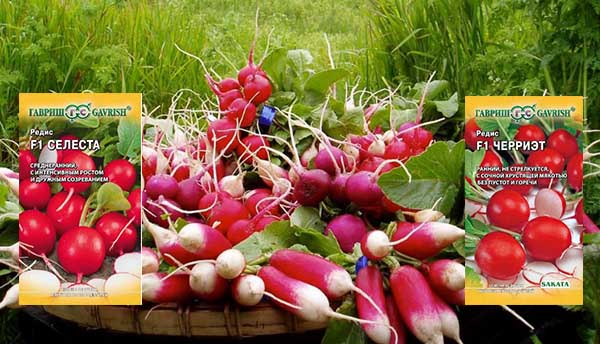
Content
How to pick a good radish variety
The main characteristics that you should focus on when choosing the right type of radish for you:
- ripening period (how many days must pass from germination to technical ripeness);
- taste (juiciness) and pungency, lack of bitterness;
- shape - elongated (elongated, cylindrical), rounded (round).
- size (diameter) and weight of root crops;
- yield;
The yield will largely depend on the planting scheme (distance) and the fertility of your soil, as well as on the observance of the cultivation agrotechnology (= correct watering).
- resistance to diseases, flowering (shooting), to the formation of voids, to flabbiness (the pulp remains juicy for a long time and does not lose its crisp properties).
If the variety (hybrid) resistant to floweringthen this means that it can be grown year-round.
Important! If you want to collect seeds, then remember that only varietal radish, hybrid (F1) seeds are not suitable for re-sowing... The fact is that their maternal traits are split, and you are guaranteed not to get the radish that you planted last year.
The best varieties of radish: top 15 for open ground and greenhouses
The most popular and best varieties of radish for growing in the open field and in the greenhouse can be called (all varieties are presented alphabetically):
By the way! The most "hit" varieties of radish are the following (in terms of popularity): Celeste F1, Cherriet F1 - two major hits. Sora, Heat, Duro are the next in fame.
18 days
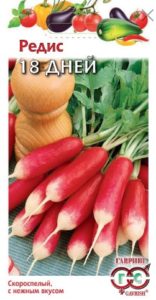
- Early ripening (18-20 days) grade.
- The root crop is elongated-cylindrical with a pink top and a white tip.
- The pulp is white, dense, crispy, slightly sharp.
- Weight - 17 g (according to other sources, 18-25 g).
- Productivity - up to 2.3-2.5 kg / m2
- Differences: amicable formation of root crops, high yield of marketable products and excellent taste.
- Used for fresh consumption.
Vella F1
The variety is especially appreciated by farmers who grow products for sale, because has similar characteristics to Celeste, while the seeds are, as a rule, 2 times cheaper.
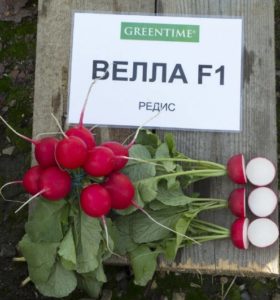
- Mid-season (25-30 days) hybrid.
- The tops are short.
- The fruits are deep red.
- The pulp is white, juicy, with a tangy taste.
- Differs in high yield even in difficult growing conditions, resistant to various diseases and shooting.
- A characteristic feature is the presence of a thin ("mouse") tail, even smaller than that of Celeste, due to which it is perfectly transported after harvest (the fruits are not damaged and are better preserved when transported over long distances).
Gloriet F1
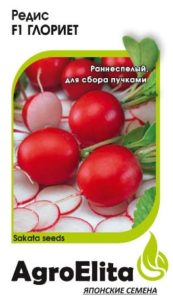
- Early ripe (23-27 days) variety (according to other sources, 20-25 days).
- The rosette of leaves is semi-upright. The tops are short. The petiole has a weak anthocyanin coloration.
- The root crop is round, convex, red.
- The pulp is white, tender, juicy, of good taste.
- Weight - 18-23 g.
- Productivity - 2.0-2.5 kg / m2.
- Practically does not form voids and does not
cracking. - Resistant to shooting (flowering), fusarium.
- For a long time retains its commercial qualities.
- Used to obtain beam products.
Duro Krasnodarskoe
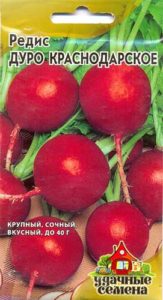
- Mid-season (25-30 days) variety.
- The root crop is rounded, up to 8-10 cm in diameter, red.
- The pulp is white, juicy, crispy, slightly spicy (sweetish). The taste is very high.
- Weight - 30-40 g.
- Productivity - 3.2-3.4 kg / m2.
- Relatively resistant to diseases, resistant to cracking and blooming.
- Used for fresh consumption. Suitable for short-term storage (up to three weeks) in a refrigerator.
Dusya F1
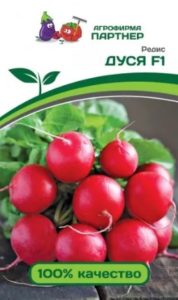
- Early ripe (23-25 days) hybrid.
- The rosette is semi-spreading, resilient, very small; the color of the petioles is strongly anthocyanin.
- Root crops have a rounded shape, a neat thin root, the tip of which is white, and the root crop itself is painted in a raspberry-pink color.
- The flesh is snow-white, oily, sparkling, delicate mild taste (no bitterness), pleasantly crispy.
- Weight - 30 g.
- Productivity - 5-6 kg / m2.
- At any age, radish does not have voids and does not flab, and retains its presentation for a long time.
Heat
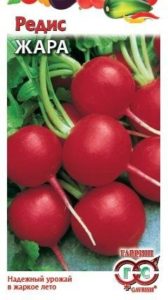
- Early ripening (21-22 days) variety (according to other sources, 18-22 days).
- The root crop is smooth, round, red-crimson.
- The pulp is white, dense, crunchy, tender, juicy, of mild taste. Good taste, contains a lot of ascorbic acid.
- Weight - 25-30 g (according to other sources, 18-27 g).
- Productivity - up to 2.3-2.8 kg / m2.
- The variety is heat-resistant, appreciated for the quick filling of high-value root crops even with insufficient watering.
- Medium resistant to flowering.
Cranberries in sugar
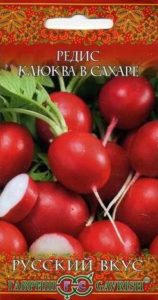
- Early ripening (20-25 days) grade.
- Root crops are red, round, large, up to 4-5 cm in diameter. The skin is thin.
- The pulp is white, delicate, of mild taste.
- Weight - up to 30-40 g.
- It is appreciated for the quick filling of large root crops, their evenness, a small rosette of leaves.
- Great for bulk picking per bundle.
- It is used fresh, in salads with sauce, vegetable snacks and okroshka, large root vegetables can be stuffed with cheese and ham.
Alice F1 Dream
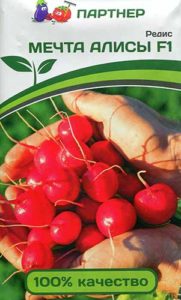
- Early ripe (22-25 days) hybrid.
- The rosette of leaves is compact, erect.
- Root crops are round in shape, with a smooth surface, identical in shape, deep red in color. Diameter - 2.5-3 cm.
- The pulp is juicy, dense, crispy, white, sparkling. The palatability is excellent, despite the presence of a light, piquant pungency.
- Weight - up to 30 g.
- Productivity - 3.5-4.5 kg / m2.
- Resistant to flowers.
- The marketability of root crops is high. Even with prolonged storage, voids, flabby, flabby or fibrous tissues do not form in root crops.
- Collecting root crops is facilitated by being shallow in the soil.
Rondar F1
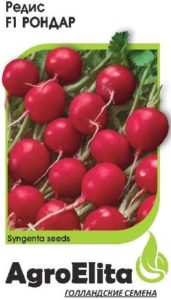
- Early ripe (20-23 days) hybrid (according to other sources, 20-28 days).
- The rosette of leaves is semi-upright.
- The root crop is rounded, red, with a beautiful tip.
- The pulp is white and juicy. The taste is excellent.
- Weight - 7-15 g (according to other sources, up to 30 g).
- Productivity - up to 3-3.5 kg.
- Resistant to flowers.
- It is characterized by amicable formation of root crops.
- Well transported (it will not flake for a long time).
Sachs RS
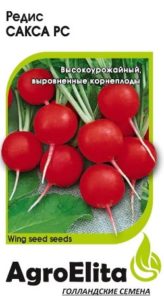
- Early ripe (23-27 days) variety (according to other sources, 20-25 days).
- The rosette of leaves is semi-raised, small and compact.
- The root crop is round, aligned, bright red.
- Weight - 15-20 g.
- The pulp is white, juicy, tender, juicy, with a pleasant mild taste.
- The variety is resistant to flowering.
- Recommended for fresh consumption.
- Differs in high yield and excellent commercial qualities, well transported (not flabby).
Celeste F1
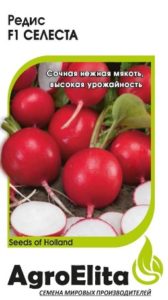
- Mid-season (23-27 days) hybrid (according to other sources, early-maturing, 23-25 days).
- The rosette of leaves is erect. The petiole has a weak anthocyanin coloration.
- The root crop is rounded, red, the head is flat.
- The pulp is white, tender, juicy, crispy, slightly sharp. The taste is excellent.
- Root weight - 18-23 g (up to 30 grams).
- Productivity - 1.5-1.7 kg / m2 (according to other sources, up to 5 kg).
- Resistant to disease. Resistant to flowering (does not form arrows and peduncles).
- Root crops are stored for a long time (not flabby) and are well transported.
- Differs in high germination and amicable ripening of root crops. Easy to pull out. It is characterized by high uniformity in shape and weight.
Sora
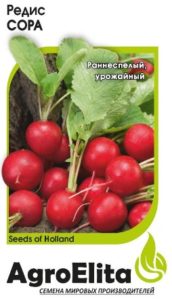
- Early maturing (22-25 days) grade.
- The rosette of leaves is erect, small, compact.
- The root crop is red, rounded, the head is convex, of medium size, 3-4 cm in diameter. The root is thin, short.
- The pulp is white, juicy, dense, slightly sharp.
- Weight - 15 g (according to other sources, up to 25-30 g).
- Productivity - up to 2.5-3.5 kg / m2 (according to other sources, up to 8 kg / m2).
- Relatively resistant to disease, does not shoot (resistant to flowering).
- It tolerates both low and high temperatures.
- Keeps marketable quality for a long time, is well transported.
- It is used to obtain bundled products and in summer vitamin salads.
French breakfast
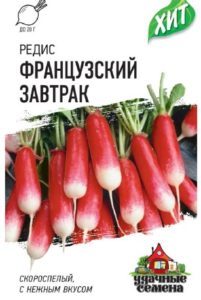
- Early maturing (21-24 days) variety (according to other sources, early maturing, 20-25 days).
- The root crop is elongated (cylindrical), with a white tip, 2-3 cm in diameter.
- The pulp is white, juicy, crispy, tender, without bitterness. The taste is excellent.
- Weight - up to 20 g.
- Productivity 2.0-2.3 kg / m2 (according to other sources, up to 3.5 kg).
- The root crop is completely submerged in the soil.
- The variety is resistant to stalking (flowering).
- Differs in amicable ripening.
- Recommended for growing in open field, spring greenhouses, film shelters.
Champion
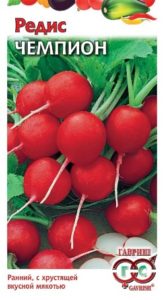
- Early maturing (24–27 days) variety (according to other sources, 20–25 days).
- The rosette of leaves is half-raised.
- The root crop is red, elongated-rounded, smooth, completely submerged in the soil.
- The pulp is white, tender, juicy, crunchy and spicy.
- Root weight - 18–20 g.
- Productivity - 1.1–2.5 kg / sq.m.
- The value of the variety: early and rapid formation of root crops, good taste, resistance to void formation, flabbiness (the pulp does not lose its crisp properties for a long time).
- Resistant to flowering (does not shoot).
- Used to obtain beam products.
Cherriet F1
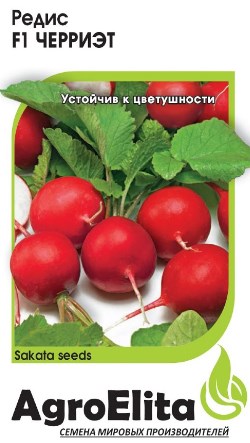
- Medium late (25-30 days) hybrid (according to other sources, early - 23-25 days).
- The tops are short, compact and strong. Semi-upright socket
- Root crops are red, rounded.
- The pulp is juicy and crispy, without bitterness. Excellent taste, average pungency.
- Weight - 25-30 g.
- Productivity - 2.4-2.7 kg / m2 (according to other sources, up to 5-6 kg / m2).
- Even when harvesting very large root crops, voids do not form in them and they do not lose moisture.
- The hybrid is resistant to flowering (no arrow).
Other good varieties and hybrids
Slightly less popular, but highly recognized and reliable varieties and hybrids of radish are also (alphabetically):
- Aurora;
- Dubel F1;
- Diego F1;
- Carmen;
- Corsair;
- Ice icicle;
- Melito F1;
- Mercado;
- Parat;
- Presto;
- Riesenbutter;
- Rover F1;
- Rudolph F1;
- Tarzan F1.
Shooting resistant
Almost all of the above varieties are resistant to shooting (flowering), namely: Vella F1, Gloriet F1 Duro Krasnodarskoe, Heat, Alice F1 dream, Rondar F1, Saks RS, Celeste F1, Sora, French breakfast, Champion, Cherriet F1. Except - 18 days, Dusya F1 and Cranberries in sugar.
The following radish varieties are also resistant to shooting: Tarzan F1, Rudolph F1, Rover F1, Parat, Diego F1, Aurora and Ice Icicle.
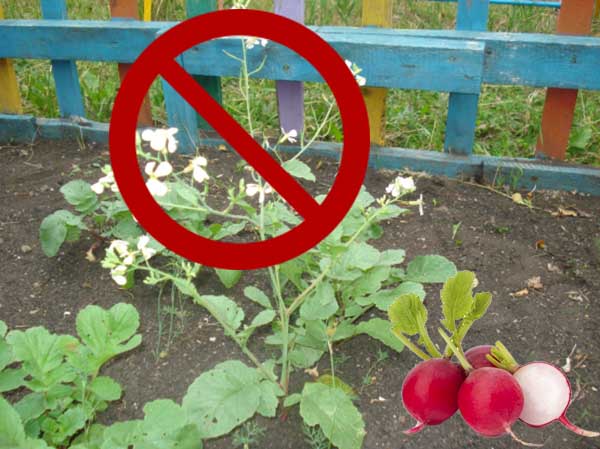
By the timing of ripening - early, mid- and late-ripening
- Early ripening (the earliest - from 16-20 days) - 18 days, Heat, Cranberries in sugar, Rondar F1, French breakfast plus Corsair, Presto, Rudolph F1, Rover F1, Melito F1, Dubel F1, Aurora.
- Early ripe (from 20-22 to 25 days) - Gloriet F1, Dusya F1, Alice's Dream F1, Saks RS, Sora, Champion as well as Riesenbutter, Diego F1.
The division of radish varieties into early maturing and early maturing is rather arbitrary.
- Mid-season (from 25 to 30-33 days) - Vella F1, Duro Krasnodarskoe, Celeste F1, Cherriet F1, as well as Tarzan F1, Parat, Mercado.
- Late (30 to 40 days) - Ice Icicle, Red Giant, Dungan 12/8, Würzburg 59, Autumn Giant.
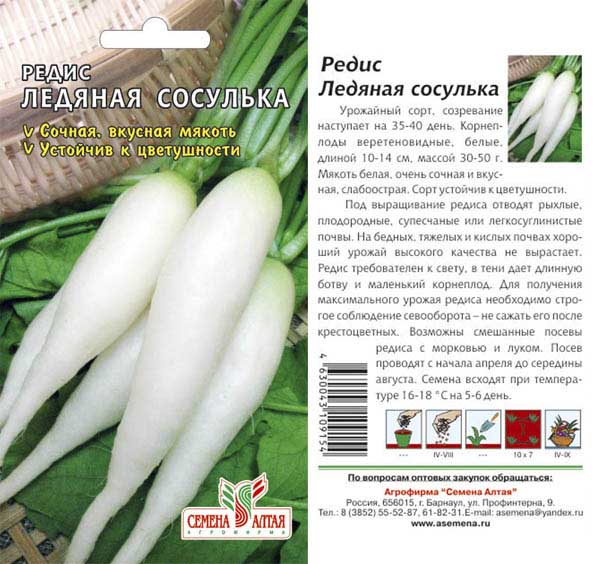
Plant different varieties, experiment, try everything yourself. "There is no comrade for taste and color, as they say." What an interest to constantly plant round varieties if you can try the elongated ones.
Note! The list of the best varieties of radish was prepared based on the degree of popularity of the names of varieties and hybrids, an analysis of the reviews of experienced gardeners, as well as the personal opinion of the author.

